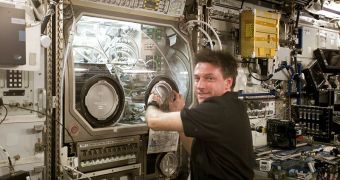On Friday, September 23, astronauts aboard the International Space Station (ISS) conducted an important training exercise, which saw them rehearsing the proper course of action in case a cabin pressure leak occurs.
At this point, Expedition 29 only has three crew members, until the next Russian Soyuz space capsule delivers the second part of the crew later this year. Even so, the three astronauts went through the necessary paces, which may one day save their lives in case of emergency.
In the event such a crisis occurs, astronauts would first and foremost cease all activities aboard the station, while simultaneously placing all relevant systems in safe mode. After the point of depressurization is isolated and confined, the crew may or may not board their Soyuz lifeboat.
When the station is manned by six astronauts, there are always two Soyuz space capsules docked to the orbital lab. In case the ISS needs to be abandoned, the crew is separated in two groups of three, each of which climbs the same spacecraft that brought them to low-Earth orbit (LEO) in the first place.
There are numerous safety procedures in place aboard the lab that involve astronauts taking refuge in the lifeboats. One such contingency is when micrometeorites or orbital junk come within the ISS' security zone, an area around the station where no foreign object should ever be.
According to NASA Mission Control, astronauts undergo training and exercise routines once every 2.5 months, which means that every long-term crew undergoes two such events. The goal here is to ensure that astronauts are very well familiarized with the procedures and equipment needed in an emergency.
“Commander Mike Fossum spent some time in the Tranquility module replacing the fluids control and pump assembly in the Water Recovery System. He also checked out scanners ensuring they operate properly and connect to an inventory management system database,” a NASA press release explains.
“Sergei Volkov, a flight engineer responsible for the station’s Russian segment, photographed and cleaned fans in the Rassvet mini-research module. Volkov also repressurized the station’s oxygen using a docked Progress cargo vehicle’s supply,” the document adds.
“Japanese astronaut and Flight Engineer Satoshi Furukawa inspected the COLBERT treadmill’s pulley teeth, motor and lateral belts and greased the forward and rear axles. The yearly inspection took up the majority of Furukawa’s day as he also checked speed performance and signs of wear and tear,” it concludes.

 14 DAY TRIAL //
14 DAY TRIAL //